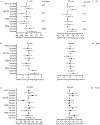Associations of gestational exposure to organophosphate esters with gestational age and neonatal anthropometric measures: The HOME study
- PMID: 36341822
- PMCID: PMC9884151
- DOI: 10.1016/j.envpol.2022.120516
Associations of gestational exposure to organophosphate esters with gestational age and neonatal anthropometric measures: The HOME study
Abstract
Organophosphate esters (OPEs) are developmental toxicants in experimental studies of animals, but limited evidence is available in humans. We included 340 mother-infant pairs in the Health Outcomes and Measures of the Environment (HOME) Study (Cincinnati, Ohio, USA) for the analysis. We evaluated gestational exposure to OPEs with gestation age at birth and newborn anthropometric measures. We quantified four OPE urinary metabolites at 16 weeks and 26 weeks of gestation. We extracted gestational age at birth, newborn weight, length, and head circumference from the chart review. We calculated z-scores for these anthropometric measures and the ponderal index. We used multiple informant models to examine the associations between repeated OPE measurements and the outcomes. We used modified Poisson regression to estimate the association of gestational exposure to OPEs with preterm birth. We also explored effect modification by infant sex and the potential mediation effect by the highest maternal blood pressure and glucose levels. We found that bis(2-chloroethyl) phosphate (BCEP) at 16 weeks and diphenyl phosphate at 26 weeks of pregnancy were positively associated with gestational age and inversely associated with preterm birth. In female newborns, BCEP at 16 weeks was inversely related to birth weight and length z-scores. In male newborns, we observed negative associations of 26-week di-n-butyl phosphate with the ponderal index at birth. No mediation by the highest maternal blood pressure or glucose levels during pregnancy was identified. In this cohort, gestational exposure to some OPEs was associated with gestational age, preterm birth, and neonatal anthropometric measures. Certain associations tended to be window- and infant sex-specific.
Keywords: Gestational age; Organophosphate esters; Pregnancy outcomes; Preterm birth.
Copyright © 2022 Elsevier Ltd. All rights reserved.
Conflict of interest statement
Declaration of competing interest The authors declare that they have no known competing financial interests or personal relationships that could have appeared to influence the work reported in this paper.
Figures


Similar articles
-
Gestational exposure to organophosphate esters and infant anthropometric measures in the first 4 weeks after birth.Sci Total Environ. 2023 Jan 20;857(Pt 1):159322. doi: 10.1016/j.scitotenv.2022.159322. Epub 2022 Oct 8. Sci Total Environ. 2023. PMID: 36220473 Free PMC article.
-
Maternal urinary concentrations of organophosphate ester metabolites: associations with gestational weight gain, early life anthropometry, and infant eating behaviors among mothers-infant pairs in Rhode Island.Environ Health. 2020 Sep 11;19(1):97. doi: 10.1186/s12940-020-00648-0. Environ Health. 2020. PMID: 32917231 Free PMC article.
-
Gestational exposure to organophosphate esters and adiposity measures of children up to 6 years: Effect modification by breastfeeding.Int J Hyg Environ Health. 2023 Mar;248:114089. doi: 10.1016/j.ijheh.2022.114089. Epub 2022 Dec 5. Int J Hyg Environ Health. 2023. PMID: 36481744
-
Relationships of prenatal organophosphate ester exposure with pregnancy and birth outcomes: A systematic scoping review of epidemiological studies.Ecotoxicol Environ Saf. 2023 Mar 1;252:114642. doi: 10.1016/j.ecoenv.2023.114642. Epub 2023 Feb 13. Ecotoxicol Environ Saf. 2023. PMID: 36791503
-
Organophosphate Esters: Are These Flame Retardants and Plasticizers Affecting Children's Health?Curr Environ Health Rep. 2019 Dec;6(4):201-213. doi: 10.1007/s40572-019-00258-0. Curr Environ Health Rep. 2019. PMID: 31755035 Free PMC article. Review.
Cited by
-
Exposure to organophosphate esters and maternal-child health.Environ Res. 2024 Jul 1;252(Pt 2):118955. doi: 10.1016/j.envres.2024.118955. Epub 2024 Apr 18. Environ Res. 2024. PMID: 38640988 Free PMC article. Review.
-
Integrated Approach for Testing and Assessment for Developmental Neurotoxicity (DNT) to Prioritize Aromatic Organophosphorus Flame Retardants.Toxics. 2024 Jun 18;12(6):437. doi: 10.3390/toxics12060437. Toxics. 2024. PMID: 38922117 Free PMC article.
-
Organophosphate Ester Flame Retardants and Plasticizers in Relation to Fetal Growth in the LIFECODES Fetal Growth Study.Environ Health Perspect. 2024 Jul;132(7):77001. doi: 10.1289/EHP14647. Epub 2024 Jul 5. Environ Health Perspect. 2024. PMID: 38968089 Free PMC article.
-
An assessment of organophosphate ester mixtures and the placental transcriptome.Environ Int. 2025 Apr;198:109402. doi: 10.1016/j.envint.2025.109402. Epub 2025 Mar 19. Environ Int. 2025. PMID: 40132437 Free PMC article.
-
Sex-specific effects of prenatal organophosphate ester (OPE) metabolite mixtures and adverse infant birth outcomes in the maternal and developmental risks from environmental and social stressors (MADRES) pregnancy cohort.Environ Res. 2023 Jun 1;226:115703. doi: 10.1016/j.envres.2023.115703. Epub 2023 Mar 17. Environ Res. 2023. PMID: 36934865 Free PMC article.
References
-
- Andrae NJ, others, 2008. Durable and environmentally friendly flame retardants for synthetics.
-
- Benjamini Y, Yekutieli D, 2001. The control of the false discovery rate in multiple testing under dependency. Ann. Statist 29. 10.1214/aos/1013699998 - DOI
-
- Blum A, Behl M, Birnbaum LS, Diamond ML, Phillips A, Singla V, Sipes NS, Stapleton HM, Venier M, 2019. Organophosphate Ester Flame Retardants: Are They a Regrettable Substitution for Polybrominated Diphenyl Ethers? Environ. Sci. Technol. Lett 6, 638–649. 10.1021/acs.estlett.9b00582 - DOI - PMC - PubMed
-
- Blum A, Gold MD, Ames BN, Kenyon C, Jones FR, Hett EA, Dougherty RC, Horning EC, Dzidic I, Carroll DI, Stillwell RN, Thenot J-P, 1978. Children Absorb Tris-BP Flame Retardant from Sleepwear: Urine Contains the Mutagenic Metabolite, 2,3-Dibromopropanol. Science 201, 1020–1023. 10.1126/science.684422 - DOI - PubMed
MeSH terms
Substances
Grants and funding
LinkOut - more resources
Full Text Sources
Miscellaneous

